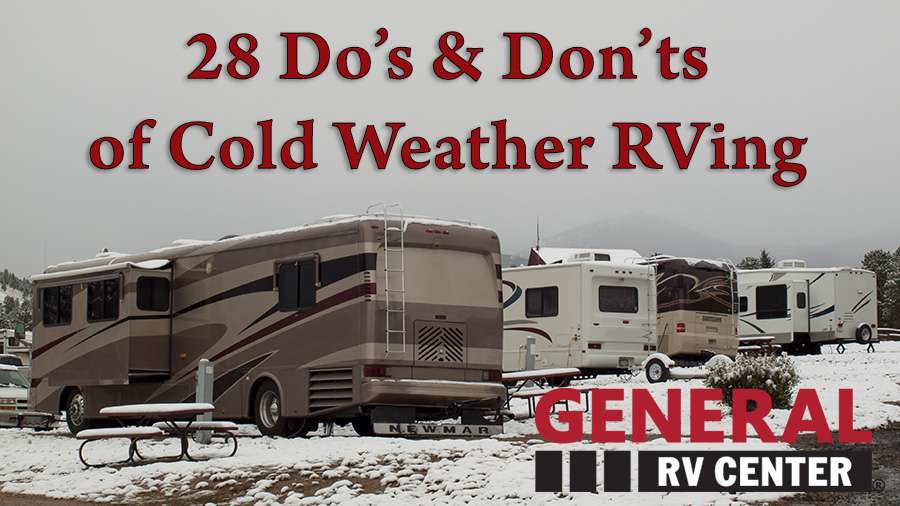 Let’s get this disclaimer out in the open right away: We don’t camp in cold weather. We couldn’t even if we wanted to. Our camper is a hybrid, or expandable, RV, meaning cold temperatures would make our canvas bed ends extremely susceptible to tears. Not to mention teeth-chattering cold.
Let’s get this disclaimer out in the open right away: We don’t camp in cold weather. We couldn’t even if we wanted to. Our camper is a hybrid, or expandable, RV, meaning cold temperatures would make our canvas bed ends extremely susceptible to tears. Not to mention teeth-chattering cold.
If you haven’t purchased your motorhome yet and you know you will be using it in cold weather, see if the manufacturer offers an arctic package option. Some packages include higher R-factor insulation values, enclosed underbelly, heated holding tanks, dual pane windows and more. Owners of these RVs are the lucky ones because the peace, quiet and solitude of cold weather RVing simply can’t be beat.
So, for this post I scoured the Internet for some tips of what to do and what not to do, for cold weather RV camping.
First up is some great advice Mark Polk of RV Education 101. Mark is one of the industry’s leading RV professionals. He’s been helping newbies and veterans alike learn more about how to RV the right way for several decades. Plus, I recently got to meet him in person for the first time, after having corresponded electronically for several years, at the recent National RV Trade Show in Louisville, Ky.
- DO determine whether you’ll be camping when temperatures are below freezing. If so, the water in your RV’s lines could freeze and turn a wonderful trip into an expensive disaster. If you will encounter freezing temps, simply make sure your RV is winterized. You can still use the bathroom with jugs of water and antifreeze in the holding tanks. On that note, know where your water tanks and water lines are located on your RV. On many RVs the tanks and lines are in heated compartments. But some are not, and it’s important to know whether yours is susceptible to freezing.
- DON’T seek a campsite that isn’t exposed to the sun as much as possible. Let the heat of the sun’s rays warm your RV during the day and give your heater a bit of a break.
- DO make sure you are fully aware of how to use your RV’s forced air heater, as well as the amount of LP it will draw. If you’ll be using an electric-powered ceramic heater, ensure you are using it according to the manufacturer specifications and always have safety in mind. For example, make sure the area immediately in front of the heat source is free of combustible materials, such as bedding.
- DON’T store any water hoses with water in them. If you need to use it, it will probably be frozen. You can take it inside to thaw out if need be, or use a hair dryer.
- DO cover the windows with curtains, drapes or almost anything will help to hold some of the heat in.
- DON’T close cabinets or drawers where water lines are located. Leave them open to allow heat to circulate around plumbing.
- DO place cut-to-size foam in ceiling vents to keep heat from escaping.
- DON’T open the entry door any more than minimally possible.
- DON’T forget the electric blanket.
Next up are Jason and Nikki Wynn from the popular Gone With The Wynns blog. Their post on winter weather camping has a slew of ideas, many of which echo Mark’s advice while others I’ve highlighted below:
- DO consider skirting the exterior of your RV. It can be as simple as DIY insulated panels cut to fit, but the more you can prevent cold air from getting under your RV, the warmer it will be inside.
- DON’T forget to use wiper fluid specially formulated to withstand winter cold.
- DO use a diesel fuel supplement for diesel pusher motorhomes. It prevents diesel from gelling.
- DON’T cover any exhaust vents or the exhaust tailpipe with RV skirting, and clear snow accumulation from these areas.
- DO consider using a heated water hose when connecting to the campground water supply.
- DON’T be connected to the full hookup sewer 100% of the time, otherwise Jason says you could end up with a “poopsicle.”
- DO run the RV’s LP furnace at 45 degrees and use it to supplement an electric heater, which is the primary source.
Finally, the folks at Trailer Life have some additional tips that are worth your while:
- DO check to make sure weather-stripping around doors and windows isn’t torn or frayed.
- DO consider installing a holding tank heater.
- DO install plastic film over your windows, especially if their single pane. The kits are available at any hardware store and are simple to install.
There you have it. If you’re willing to camp in the winter, there’s not too much you need to do to make it comfortable.
See you next week!
Rick Kessler
(Gr8LakesCamper)
Gr8LakesCamper celebrates the world of RV Camping in the Great Lakes region. Gather around the campfire and share tips, ideas and stories on RVing, camping and travel destinations. Follow Gr8LakesCamper on Twitter, Facebook, Pinterest and the Gr8LakesCamper blog.